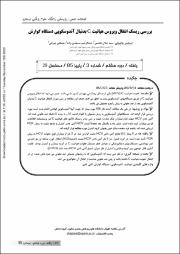| dc.contributor.author | Hajiani, eskandar | en_US |
| dc.contributor.author | Hashemi, seyed jalal | en_US |
| dc.contributor.author | Masjedi-zade, abdolrahim | en_US |
| dc.contributor.author | Cheraghi, mostafa | en_US |
| dc.date.accessioned | 1399-08-21T21:46:39Z | fa_IR |
| dc.date.accessioned | 2020-11-11T21:46:39Z | |
| dc.date.available | 1399-08-21T21:46:39Z | fa_IR |
| dc.date.available | 2020-11-11T21:46:39Z | |
| dc.date.issued | 2006-11-01 | en_US |
| dc.date.issued | 1385-08-10 | fa_IR |
| dc.identifier.citation | Hajiani, eskandar, Hashemi, seyed jalal, Masjedi-zade, abdolrahim, Cheraghi, mostafa. (2006). Risk of Hepatitis C Virus transmission Following Upper Gastrointestinal Endoscopy. scientific magazine yafte, 8(3), 47-54. | en_US |
| dc.identifier.issn | 1563-0773 | |
| dc.identifier.uri | http://yafte.lums.ac.ir/article-1-1025-en.html | |
| dc.identifier.uri | https://iranjournals.nlai.ir/handle/123456789/483488 | |
| dc.description.abstract | Background: Hepatitis C virus infection (HCV) is a main health problem in our country. It is thought that the transmission of hepatitis C virus (HCV) through the endoscopic procedures is a rare event. The aim of this study was to evaluate the risk of conventional disinfection in the transmission of HCV.
Materials and methods: A prospective study, comprising 456 consecutive upper gastrointestinal endoscopies was carried out in our endoscopy centers by using conventional disinfection (exposure of the endoscope to 2% glutaraldehyde for 4 minutes),Without altering the routine procedures. Anti-HCV antibodies were tested for all patients and a questionnaire was fulfilled by the patients to obtain information regarding the risk factors for HCV infection. Six months and one year later anti-HCV antibodies were repeated and positive results were confirmed by the PCR method.Five hundred healthy blood donors were used for the control group.
Results: Five patients (1.09%) were anti-HCV-antibody positive. Anti-HCV-antibody-positive patients confirmed in three patients by PCR method . Anti-HCV antibodies were found in 6 healthy blood donors (1.2%) of controls.Transfusion, non-intravenous (i.v.) drug abuse, dental procedures, were found to be independent risk factors of HCV-positive the patients and controls groupsNo significant differences were observed between the patients and controls groups regarding the frequency of anti-HCV antibodies (P = 0.74).
Conclusion: HCV does not seem to transmit through the endoscopic procedures. Conventional disinfection of the endoscope and accessories is sufficient for prevention of HCV transmission. | en_US |
| dc.format.extent | 164 | |
| dc.format.mimetype | application/pdf | |
| dc.language | English | |
| dc.language.iso | en_US | |
| dc.relation.ispartof | scientific magazine yafte | en_US |
| dc.relation.ispartof | مجله علمی پژوهشی یافته | fa_IR |
| dc.subject | Hepatitis | en_US |
| dc.subject | Endoscopy | en_US |
| dc.subject | Gastrointestinal system | en_US |
| dc.subject | Antibody | en_US |
| dc.title | Risk of Hepatitis C Virus transmission Following Upper Gastrointestinal Endoscopy | en_US |
| dc.type | Text | en_US |
| dc.type | Research | en_US |
| dc.citation.volume | 8 | |
| dc.citation.issue | 3 | |
| dc.citation.spage | 47 | |
| dc.citation.epage | 54 | |





